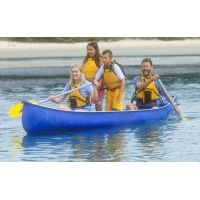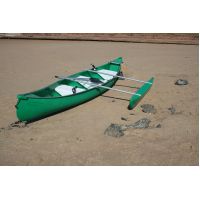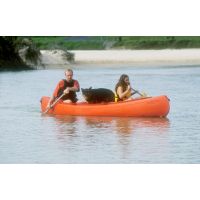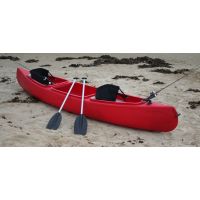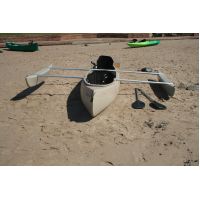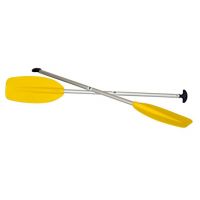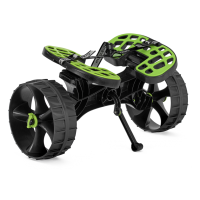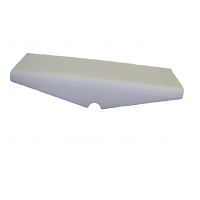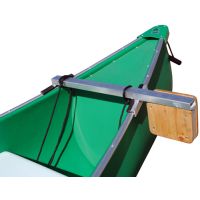Cart is empty
Buying a Sea Kayak
Here is some background knowledge so you know what to look for and can ask relevant questions and so be able to make an informed decision when purchasing. If you require further information, please contact Australis on 02 4285 2000.
There is a separate page for:
What to look for in a SEA KAYAK
This section outlines the features to look for when looking at a sea kayak.
If you require further information, please contact Australis on 02 4285 2000.
Features
- Seat
- Backrest
- Thigh Brace
- 6mm Deck Lines
- Rudder
Pricing
- Standard Features
FEATURES
Seat
The most important feature of a sea kayak is the seat!
If your sea kayak does not have a comfortable seat, it will not be pleasant to paddle for extended periods of time. You also need to remember that if you are paddling off-shore, you will not be able to get out and move around if you end up with a sore backside or pins and needles in your legs.
Make sure that the edges of the seat are soft curvy profiles that follow the shape of your legs and that there are no sharp corners to dig into you causing pain or interfering with the flow of blood to and from your legs.
To check the comfort of the seat, make sure that you take any sea kayak that you are considering purchasing for a "Test Paddle" as seats that look padded or soft do not always prove to be comfortable in reality.
The bottom line is...
Look for a sea kayak with soft, flowing edges and make sure that you test the seat to make sure that it will be comfortable for long paddling sessions.
Backrest
The next feature that you will need to consider is the backrest.
The backrest plays an important role because it holds your pelvis in a supported position, which is especially important during extended periods of paddling.
The angle you will set your backrest at will depend on whether you like to sit fairly upright or whether you have a more relaxed paddling style.
(Please be aware that if you set the angle of your backrest too far back, your pelvis will rotate forward and up, putting pressure the front of the lumbar vertebrae and the muscles of the lower back. It is best to sit nearly upright because in this position, your back will receive support from your abdominal muscles.)
Some kayaks have a lot of padding on the seat. Whilst this can add some comfort, padding is not important if you are not properly supported.
A backrest that can be folded forward allows you to store items like warm clothing behind your seat, so they are readily accessible if the weather turns cold or if you need a pump to bail your kayak.
Some kayaks have a "podded" seat which does not allow you to store anything in the cockpit that you might need to have quick access to.
The bottom line is...
Look for a backrest where the angle can be changed to suit your preferred seating position. It is even better if the backrest can also be folded forward to store things in behind the seat.
Thigh Brace
Look for a sea kayak that has a thigh brace, as this will allow you to lock into your kayak to help with rolling and bracing, and to stabilize when in choppy water.
Some kayaks have foam pads under the combing for you to push your knees against to help you lock in, but an actual thigh brace with a curved surface to match the contour of the top of your thighs will give you a more secure grip.
Also be aware that some kayaks have the thigh brace moulded in as part of the hull, and some have it as a separate piece that can be included or taken out as required.
The bottom line is...
Look for a sea kayak with an actual thigh brace (rather than just foam pads) as this will give you a more secure fit in the kayak.
It is also an advantage to have a thigh brace that can be removed for people with more muscular legs so that it is easier to get out of the kayak during a wet exit and will give more room during the re-entry.
Deck Lines
Look for a sea kayak that has a deck lines as this will give you something to grab onto during rescue procedures and places to tie dry bags that are being stored on the deck. It is recommended that the rope be at least 6mm thick for maximum required strength.
Also, try to get a rope that is "double braided" as this is stronger and is less likely to stretch than a standard single braided rope, so it will not need to be tightened as time passes.
The bottom line is...
Look for a sea kayak with decklines at least 6mm thick and with a double braid construction.
Rudder
When considering paddling off-shore, you will need to look for a sea kayak with a rudder.
Whilst a rudder does help you with turning, it is actually more helpful when trying to paddle in a straight line when you have cross-winds or a trailing sea.
Even if your sea kayak has a rudder, make sure that you can paddle it in rough conditions without using the rudder, so if your rudder ever becomes inoperational, you can still control your sea kayak and get home safely.
The bottom line is...
Look for a sea kayak with a rudder.
PRICING
Standard Features
To get a true indication of value when comparing different brands, you will need to consider what features that the manufacturer includes as "standard".
- Hatches (included in the price or an option?)
Most sea kayaks have hatches fitted as a standard feature, although some still include them as an option (for an added price).
- Hatch Size
The hatches on sea kayaks can vary in their usefulness.
Some hatches are so small that they are basically useless, and this will be an important feature to consider, especially if you will be doing over-night camping or expeditions and need to be able to put large dry bags with gear inside. Make sure that the hatch is going to be large enough to allow your possessions inside. - Rudders
- Thigh Braces
- Deck Lines
Rudders, thigh braces and deck lines are a important safety features for a sea kayak (see above) but some manufacturers now include them as optional extras so that their base price looks much more competitive (until you start to add the cost of the extra features).
The bottom line is...
Know what is included in the price as standard, and what is an option that will be included if you pay extra, and also consider the usefulness of the features.
© 2013-2025 Australis Canoes. Powered by AVS Online Store

